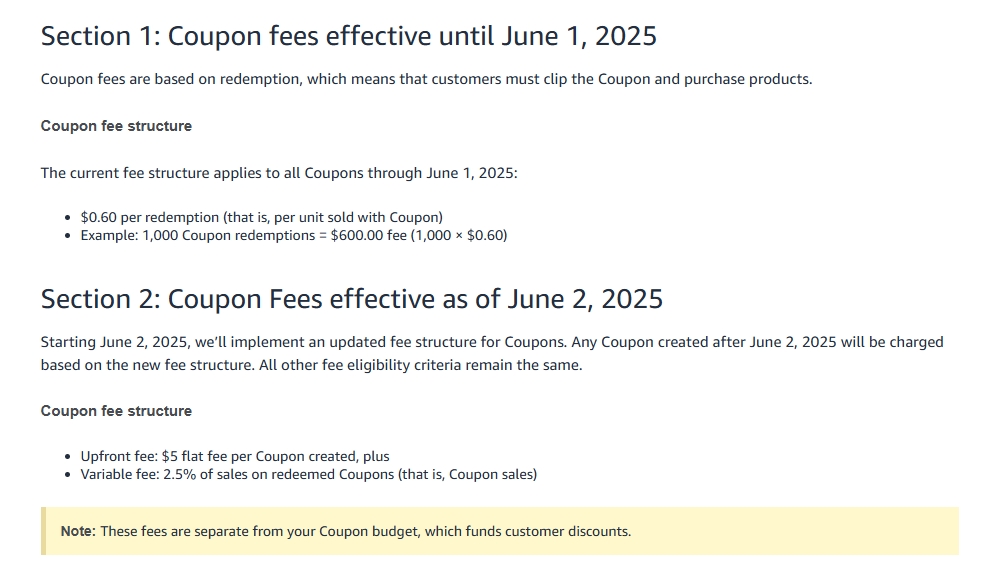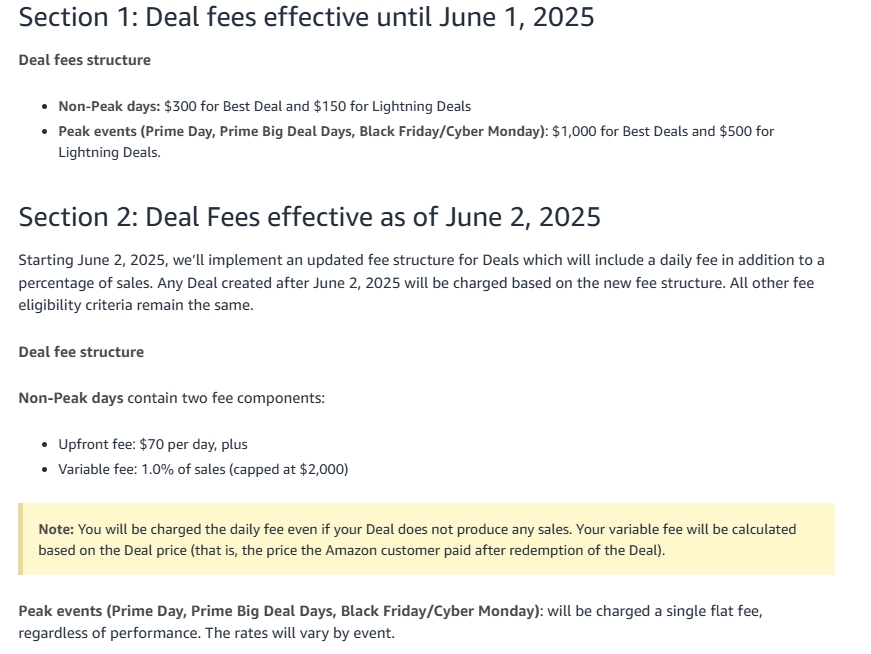On March 25, Amazon released a major update to its policies on coupons, Lightning Deals, and Prime Discounts, set to take effect on June 2, 2025. The company aims to make it easier for sellers to test promotional strategies, take better control of deal durations, reduce upfront costs, and align fees with performance to better suit sellers’ business needs.
"Prepaid + Commission" Model for Coupons
Under Amazon’s new rules, coupon fees will now be directly tied to the total sales generated by the coupon. The updated fee structure is as follows:
US Marketplace
- Upfront Fee: $5 per coupon created.
- Commission Fee: 2.5% of the total sales generated by the coupon.
European Marketplace
- Upfront Fee: €2.5 per coupon created.
- Commission Fee: 0.5% of the total sales generated by the coupon.

With the new billing model, we did a measurement across different price ranges and found that the fees were only more favorable when the item was priced at $10 and sold more than 20 units, while coupon billing for items greater than $10 only got more expensive.
| Item Price | Units Sold | Old Fee ($0.6/unit) | New Fee ($5 prepaid + 2.5% of sales) | Cost Difference | Savings? | Break-even Volume |
| $10 | 10 units | $6 | 5+(5+(10×10×2.5%) = $7.5 | $1.50 | ❌ Worse | 20 units |
| 20 units | $12 | 5+(5+(10×20×2.5%) = $10 | ($2) | ✅ Better | ||
| $20 | 10 units | $6 | 5+(5+(20×10×2.5%) = $10 | $4 | ❌ Worse | 17 units |
| 30 units | $18 | 5+(5+(20×30×2.5%) = $20 | $2 | ❌ Worse | ||
| $24 | 10 units | $6 | 5+(5+(24×10×2.5%) = $11 | $5 | ❌ Worse | 8 units |
| 50 units | $30 | 5+(5+(24×50×2.5%) = $35 | $5 | ❌ Worse | ||
| $30 | 10 units | $6 | 5+(5+(30×10×2.5%) = $12.5 | $6.50 | ❌ Worse | Never |
| 50 units | $30 | 5+(5+(30×50×2.5%) = $42.5 | $12.50 | ❌ Worse | ||
| $50 | 10 units | $6 | 5+(5+(50×10×2.5%) = $17.5 | $11.50 | ❌ Worse | Never |
Amazon sellers are saying that this policy update is crazy and that it will hit high unit price products hard.
Assuming a product is priced at $500 with a fixed coupon discount of $50 and 200 redemptions, the total sales of the item will be $90,000.Under the original coupon policy, the seller would only have to pay 200 * 0.6 = $120 in redemption fees.But now, under the new coupon policy, sellers must pay Amazon a fee of $5 + $90,000 * 2.5% = $2,255, an almost 187% increase.
Challenges for Small and Medium-Sized Sellers
The upfront $5 (or €2.5) fee is non-refundable, which increases the cost of trial and error for sellers who frequently toggle coupons on and off. For small and medium-sized sellers, this creates additional pressure to carefully plan their promotions to avoid unnecessary losses.
With limited resources, smaller sellers may find it harder to adapt to these changes, potentially leading to increased competition and even driving some out of the marketplace.
Updates to Best Deals and Lightning Deals
Amazon also announced updates to its Lightning Deals and Best Deals policies for the US marketplace. Starting June 2, sellers will have the flexibility to run Best Deals on any day of the week, with durations ranging from 1 to 14 days. However, this flexibility comes with a new fee structure:
- Base Fee: $70 per day.
- Variable Fee: 1% of total sales, capped at $2,000 per deal.
This means that even if no sales are generated, sellers will still incur the 70 daily fee.

After the new rules come into effect during the off-peak season, if an Amazon seller conducts a 3-day best deal campaign during this period, and assuming $10,000 in sales, the cost of the spike will be $310 (70×3+10,000×1%=310); if sales reach $300,000, the cost of the spike will be $2,210 (70×3+2,000 cap).= 2210).
During Peak Events like Prime Day, Black Friday, and Cyber Monday, the fees for Best Deals and Lightning Deals will remain unchanged at $1,000 and $500, respectively.
By allowing sellers to run deals more flexibly during non-peak periods, Amazon is encouraging more price competition. This could lead to aggressive price wars among sellers, particularly in categories where low pricing is already a key driver of sales.
Additionally, Amazon is rumored to be extending the duration of its 2025 Prime Day event to further capitalize on the momentum of these promotions. According to Amazon, participating products see an average sales lift of 37% during promotional periods. With competitors like Temu, SHEIN, and TikTok Shop gaining traction in the low-price market, Amazon is doubling down on its efforts to attract more budget-conscious shoppers









